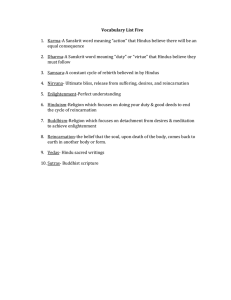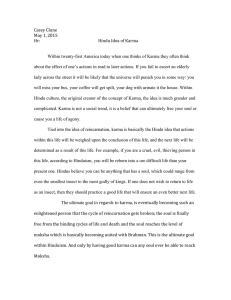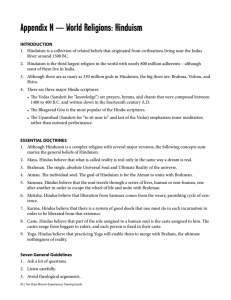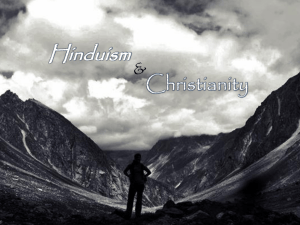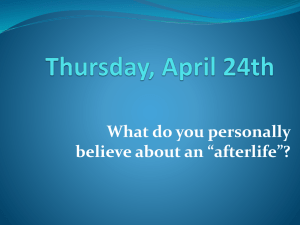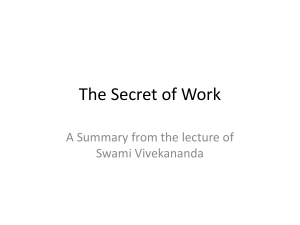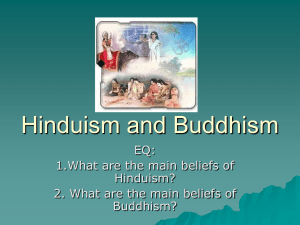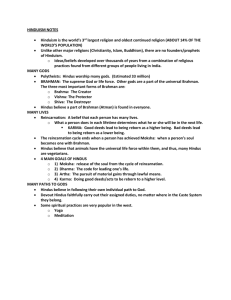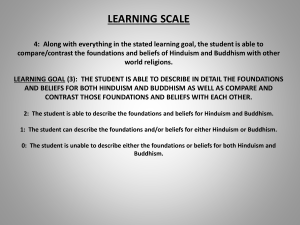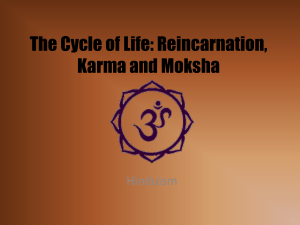Hinduism - Death and Dying
advertisement
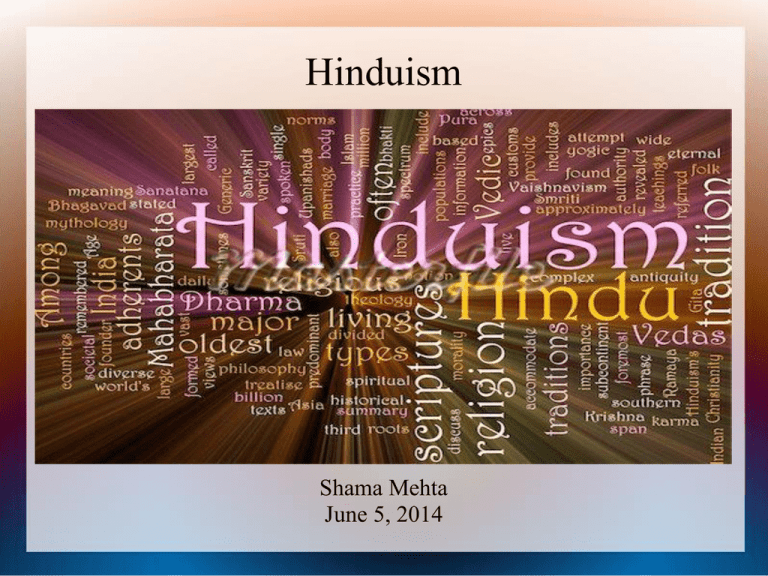
Hinduism Shama Mehta June 5, 2014 What is Hinduism? More correctly called by its Sanskrit name: Sanatana Dharma the oldest living religion in the world the world’s third largest religion; with almost a billion followers as no single founder, no one scripture, no single set of teachings, no unified code of conduct, no central governing body. 2.5 Million Hindus in the US [according to the PEW forum] Hindu Beliefs Believe in a one, all-pervasive Supreme Being who is both immanent and transcendent, both Creator and Unmanifest Reality. Believe that the universe undergoes endless cycles of creation, preservation and dissolution. Believe in karma, the law of cause and effect by which each individual creates his own destiny by his thoughts, words and deeds Hindus respect the fact that each has its own pathway to the one God. Beliefs : Ahimsa - Non-Violence Ahimsa is abstaining from causing hurt or harm; whether physical, mental or emotional. Condemn killing, but extended to harm caused by one's thoughts, words and deeds of all kinds--including injury to the natural environment. Even the intent to injure, even violence committed in a dream, is a violation of the principle of ahimsa. Reason most Hindus are vegetarian or vegan Beliefs about Afterlife - Reincarnation Hindus believe in reincarnation Believe the soul is immortal and takes birth time and time again. Through this process, we have experiences, learn lessons and evolve spiritually. Finally we graduate from physical birth. Beliefs about Afterlife - Karma Hinduism believes that the soul is immortal, that it never dies, but inhabits one body after another on the Earth during its evolutionary journey. The process of action and reaction on all levels—physical, mental and spiritual—is karma. Like the caterpillar's transformation into a butterfly, physical death is a most natural transition for the soul, which survives and, guided by karma, continues its long pilgrimage until it is one with God. Other Beliefs affecting Health Care Cleanliness – bathing Prayer ritual – at least 2 times a day [sunrise and sunset] Vegetarianism Natural treatments – Ayurveda, homeopathy Death and Dying Hindus regard death as a most exalted human experience, the migration of the soul from one dimension of consciousness to another, a transition we have all experienced many times. Death is not to be feared, neither unnecessarily accelerated nor relentlessly delayed. The beliefs of Karma and Reincarnation are amplified during the time of death When Death is Imminent Water from holy river Ganga should be sprinkled on the body of the person and/or poured into the mouth of the person Chant the names of God in or near the right ear of the person, if possible according to the family tradition or the wish of the dying person. One may also wish to read the 7th,12th and 15th chapter of Bhagavad Gita. An oil lamp is lit and is kept burning until after death. In a hospital setting, this could be a battery-operated candle. Death and Dying Hindus do not leave the preparation of the body for disposal to professionals who are unconnected to the deceased. The family prepares the body for cremation by bathing, putting on new clothing for the deceased. They also stays with the loved one until the body is cremated The southern direction represents mortality and death and so the body is placed with its head towards the south Hindu Antyeshti Samskara What follows after death are rites and rituals that are carried out by the immediate family members. These rituals called Antyeshti Samskara that last 13 days. On the 13th day, the individual soul of the deceased is believed to have completely severed earthly relationships. Thank you!
